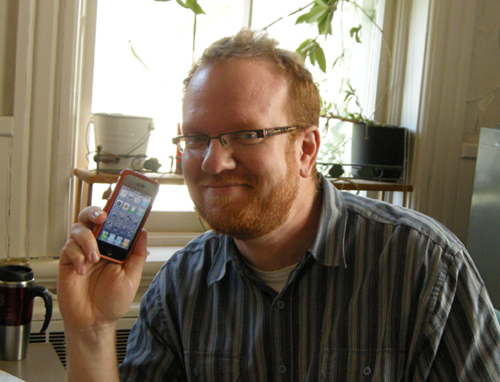
Tired of lugging your laptop around campus? The day may not be too far away when you won’t have to.
In late September, a group of Guelph students began testing a series of new applications that will allow them to access course notes, grades and updates from their phones or other mobile devices. These applications were developed by Desire2Learn (D2L) and announced at a D2L user’s conference ─ FUSION 2010 ─ held in July.
Kyle Mackie, who manages courseware services in Teaching Support Services, not only attended the conference but organized an event on the day before Fusion called the “D2L UNconference.” He explains: “There’s a strong community of D2L users ─ administrators, instructors and tech people who use the D2L software ─ but we may only meet in person once a year. The UNconference brings us together in a user-led event, where we have some short presentations about technology and solutions plus plenty of time to talk and share ideas.”
Mackie, who has been using D2L tools for more than a decade, is also on the FUSION conference steering committee. “There are always users from Guelph in attendance, but the conference is increasingly international, with users from Australia, New Zealand, Japan and Europe taking part this year.”
For D2L, the conference itself is a chance to demonstrate solutions and promote new products, such as the new mobile applications. “One reason U of G went with D2L as a campus-wide Learning Management System is proximity,” says Mackie. (D2L is based in Kitchener.) ”They have a history of working with us on development, so we’re pleased that they are testing the mobile apps here.”
During the usability tests, students can access course material, calendar information, modules and course topics and make and use bookmarks. Then they’ll report back on how easy or difficult it was to perform these tasks from mobile devices.
Mackie sees this as just the beginning. “I’m sure it’s on the roadmap to be able to also participate in discussions and do quizzes using the mobile devices. I can see it being used on field trips to museums or other locations so that you can download or send back information and stay connected even when you’re not on campus. There’s great potential to really extend and expand learning.”
Other developments showcased at the conference include a new version of the D2L Learning Environment, which includes all the course-based tools, and the e-Portfolio, a tool that allows users to build a webpage where documents, resumes, pictures, videos and presentations can be uploaded and arranged. “The completed page can then be submitted as an assignment or used when applying for a job,” Mackie says. U of G has access to an older version of the D2L tools, but Mackie is excited about the new features and usability improvements. “These will definitely enhance student learning,” he says.
He expects this new version of Learning Environment to be in place at Guelph by next summer. One of the new tools, called Course Builder, uses a drag and drop interface that Mackie says can be used to quickly build a course and then rearrange modules and learning activities as needed.
Designing these programs to work in a university environment is not a simple task. “The tools need to work for people who are using assistive devices, and that’s a challenge,” he says. “People who use screen readers have historically had difficulties with many new web technologies like drag and drop. From what I’ve seen, D2L’s approach to development meets the needs of users with disabilities.”
While he’s excited about these new developments, Mackie adds that he doesn’t want instructors to worry about changes. “We’ve been gradually migrating courses onto the D2L platform, and some are still learning it, so we will not be making changes too quickly. We won’t rock our users in a big way with too much re-learning. Instead we’ll be building on our already-solid foundation and allowing people to explore new tools, and new options.”
The mobile apps, of course, are still being tested, but Mackie anticipates they’ll be available by summer or fall of 2011. “They should work on every platform and every network, as long as you have an internet connection,” he says. “I love the idea that you’ll truly be able to learn from anywhere.”